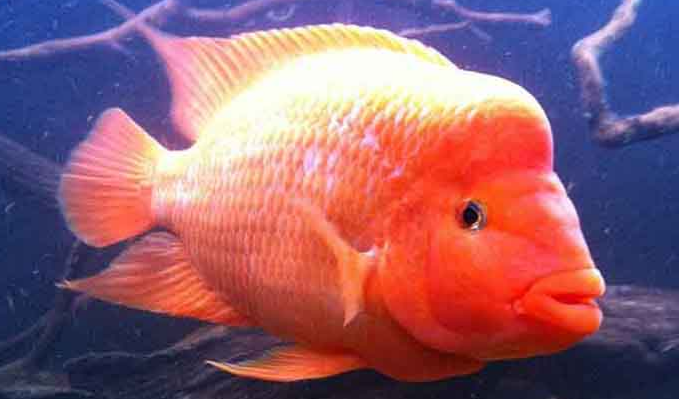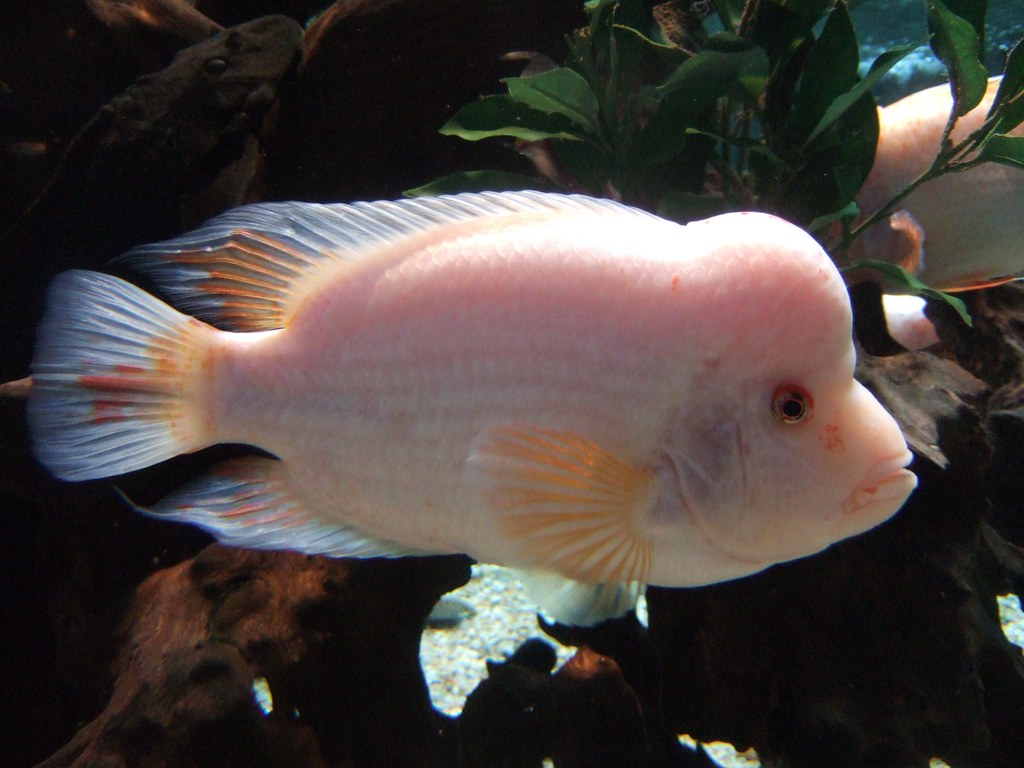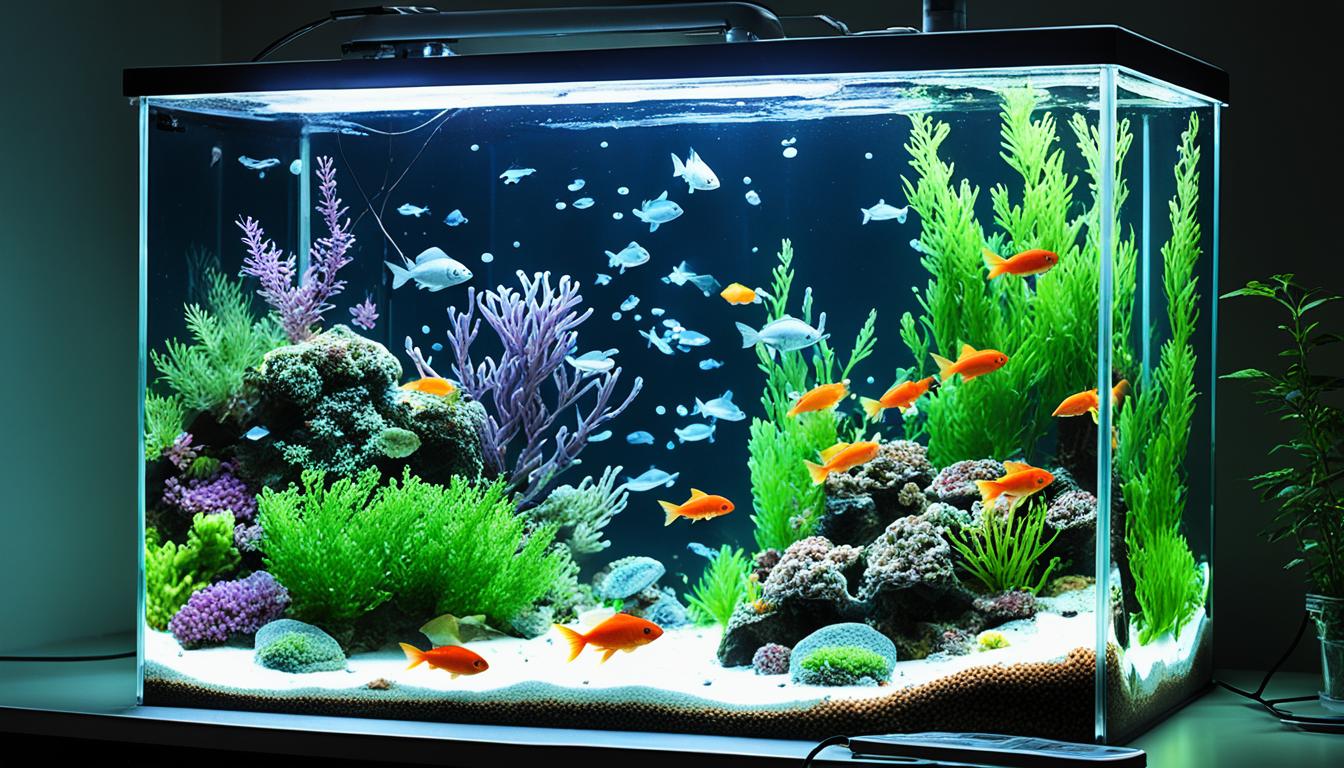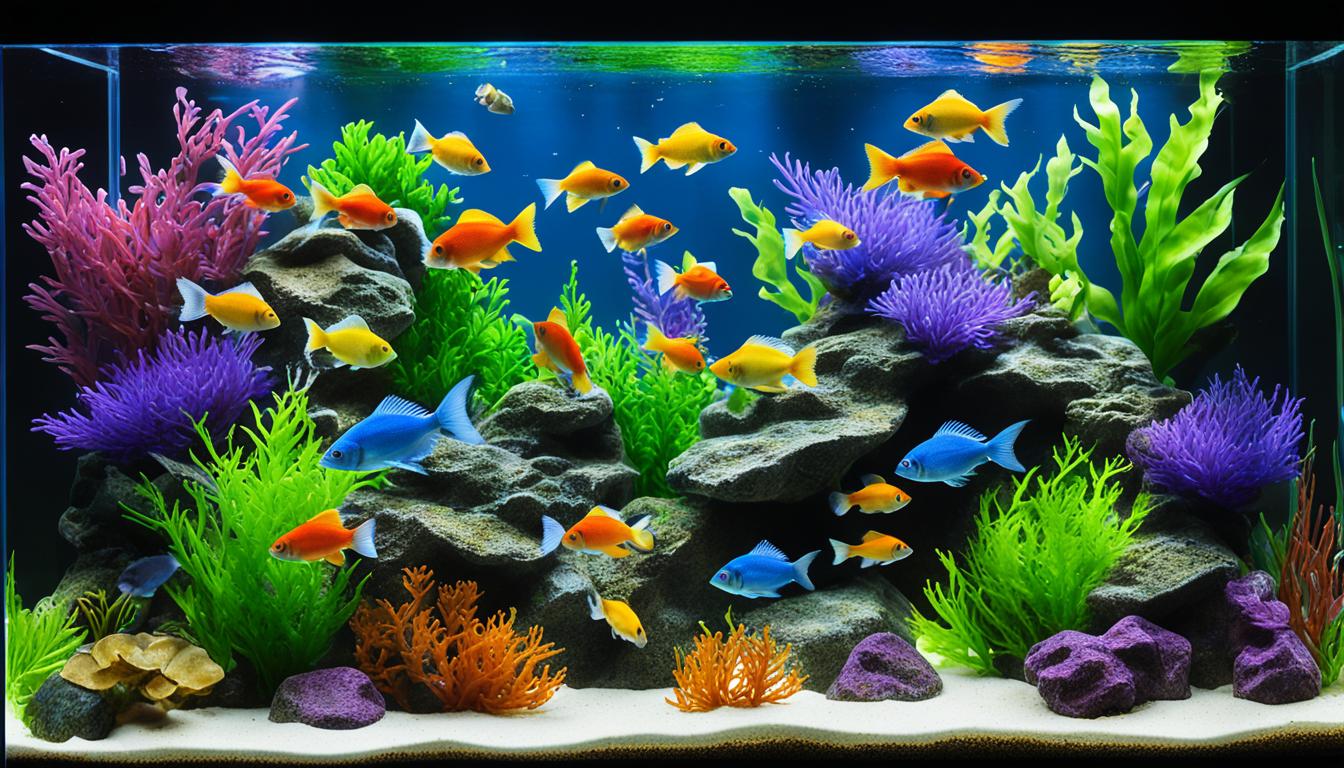The Red Devils Fish, also known as the red devil cichlid (Amphilophus labiatus), is a large, aggressive freshwater fish endemic to Lake Managua and Lake Nicaragua in Central America. They are known for their territorial behavior and will attack other fish in the tank.
They may also destroy objects in the tank. The red devil cichlid can grow up to 15 inches in length and requires a tank size that accommodates their aggressive nature. They are not suitable tank mates for peaceful or small fish.
Additionally, their diet consists of both animal and plant foods, including earthworms, bloodworms, krill, and even crickets, along with plant supplements like spirulina flakes, lettuce, broccoli, or shelled peas.
Table of Contents
Introduction To Red Devils Fish Care
The Red Devils Fish in Austin, Texas is a popular freshwater fish known for its vibrant colors and aggressive behavior. These territorial fish are best kept in spacious tanks with compatible tank mates such as plecos, jaguar cichlids, and tire track eels.
Careful attention should be given to their diet, which includes a mix of live and plant-based foods.
What Are Red Devils Fish:
- Red Devils Fish, also known as Amphilophus labiatus, is a large cichlid fish that is endemic to Lake Managua and Lake Nicaragua in Central America.
- They are characterized by their vibrant red color and aggressive nature.
- Red Devils Fish are popular among aquarium enthusiasts due to their striking appearance and unique behavior.
Origin And Habitat Of Red Devils Fish:
- Red Devils Fish are native to the lakes of Nicaragua, specifically Lake Managua and Lake Nicaragua.
- In their natural habitat, they can be found in rocky areas near the shorelines, where they create territories and defend them fiercely.
- These fish prefer warm waters with a temperature range of 75 to 82 degrees Fahrenheit.
Unique Characteristics Of Red Devils Fish:
- Aggressive Nature: Red Devils Fish are known for their aggressive behavior. They are territorial and will attack other fish in the tank. They also have a tendency to destroy anything they can get their mouths on.
- Vibrant Coloration: One of the most distinctive features of Red Devils Fish is their vibrant red color. This coloration intensifies as they mature, making them an eye-catching addition to any aquarium.
- Large Size: Red Devils Fish can grow up to 15 inches in size, which makes them a suitable choice for larger aquariums.
- Unique Personality: These fish are known for their unique personalities. They are curious and intelligent, and often interact with their owners.
- Compatibility with Tank Mates: While Red Devils Fish are aggressive, they can coexist with certain tank mates. It is advisable to choose larger and more robust fish as their tank mates to avoid any aggression issues.
By providing a comprehensive introduction to Red Devils Fish in Austin, Texas, this section aims to provide readers with a clear understanding of these fascinating fish. From their origins and habitat to their unique characteristics, everything you need to know about Red Devils Fish is covered.
So if you’re considering adding these vibrant and interesting fish to your aquarium, keep reading to learn more about them.
Care And Maintenance Of Red Devils Fish In Austin, Texas
Taking care of Red Devils Fish in Austin, Texas requires understanding their aggressive nature and providing a suitable tank size. These cool-looking fish can be compatible with other species like plecos and jaguar cichlids. Feeding them a varied diet of earthworms, bloodworms, and plant foods is essential for their health.
Red Devils Fish, also known as Amphilophus labiatus, are large cichlid fish native to Central America, specifically Lake Managua and Lake Nicaragua. They are known for their striking red coloration and aggressive temperament. If you are considering keeping Red Devils Fish as pets in your Austin, Texas aquarium, it is essential to understand their care requirements to ensure their health and well-being.
Tank Size And Water Hardness Conditions For Red Devils Fish:
- Red Devils Fish are territorial and can be quite aggressive towards other fish. It is recommended to provide them with a spacious aquarium to reduce conflicts. Ideally, the tank should be at least 75 gallons in size.
- Maintain the water hardness between 10 and 20 dH (degrees of hardness) for optimal Red Devils Fish health.
- Consider using a water testing kit to regularly check and adjust the water hardness levels.
Ideal Temperature And Ph Levels For Red Devils Fish:
- Red Devils Fish thrive in a tropical environment with a temperature range of 75-82°F (24-28°C).
- The pH level of the water should be kept between 6.5 and 7.5, which is slightly acidic to neutral.
- Ensure the tank has a reliable heater and thermometer to maintain the desired temperature consistently.
Feeding And Diet Of Red Devils Fish:
- Red Devils Fish are omnivorous and have a hearty appetite. Their diet should consist of a variety of high-quality protein-based foods, such as pellets, flakes, frozen or live insects, and small crustaceans.
- Supplement their diet with fresh vegetables like spinach, peas, and zucchini to provide essential nutrients.
- Feed them once or twice a day, only offering the amount of food they can consume within a few minutes to prevent overfeeding and water pollution.
By adhering to the appropriate tank size, water conditions, temperature, pH levels, and diet recommendations, you can provide a suitable environment for your Red Devils Fish in Austin, Texas. Remember to regularly monitor water parameters and maintain the cleanliness of the aquarium to ensure the health and happiness of your vibrant Red Devils Fish.
Compatibility Of Red Devils Fish With Other Fish Species In Austin, Texas
Red Devil Cichlids, popular in Austin, Texas, are known to be very aggressive and territorial. Suitable tank mates for these fish include other Red Devil Cichlids, plecos, jaguar cichlids, Jack Dempsey cichlids, and tire track eels.
Best Tank Mates For Red Devils Fish:
- Convict Cichlids: They are similar in size and aggression level to Red Devils, making them good companions.
- Jack Dempseys: Another aggressive cichlid that can hold its own against Red Devils.
- Green Terror Cichlids: These fish have a similar temperament to Red Devils and can coexist peacefully.
- Firemouth Cichlids: They are also known for their aggression, so they can withstand the Red Devils’ behavior.
- Silver Dollars: These peaceful fish can serve as dither fish, diverting the aggression of Red Devils.
Handling The Aggression Of Red Devils Fish:
- Provide Sufficient Space: Red Devils need ample swimming space, so a larger tank will help disperse aggression.
- Use Hiding Spaces: Provide plenty of hiding spots, such as caves or plants, to give other fish a chance to escape.
- Distract with Dither Fish: Introduce dither fish, which are fast-moving and non-threatening, to divert the Red Devils’ attention.
- Avoid Overcrowding: Crowded tanks can increase aggression, so ensure the tank has enough space for all fish.

Avoiding Compatibility Issues In Red Devils Fish Tanks:
- Avoid Fish with Long Fins: Red Devils are notorious for attacking fish with long, flowing fins, such as angelfish or bettas.
- Steer Clear of Bottom Dwellers: Bottom-dwelling fish like catfish may become targets for the Red Devils.
- Stay Away from Small Fish: Small fish may be seen as prey by Red Devils and may not survive.
- Monitor Aggression Levels: Keep a close eye on the behavior of the Red Devils and their tank mates to intervene if necessary.
- Quarantine New Fish: Before introducing new fish to the tank, quarantine them to ensure they are healthy and free from diseases or parasites that could escalate aggression.
Breeding And Reproduction Of Red Devils Fish In Austin, Texas
The Red Devils Fish, also known as Red Devil Cichlids, are large and aggressive fish endemic to Lake Managua and Lake Nicaragua in Central America. They require a spacious tank and are best suited to be alone or with other aggressive fish such as plecos, jaguar cichlids, Jack Dempsey cichlids, and tire track eels.
Their diet consists of both meat and plant foods, including earthworms, bloodworms, krill, and plant supplements. The temperature of their tank should be regulated to meet their specific needs.
The breeding and reproduction of Red Devils Fish in Austin, Texas is a fascinating topic for fish enthusiasts. Understanding their breeding behavior, setting up a breeding tank, and caring for the fish fry are all important aspects to consider. Let’s dive into it!
Understanding The Breeding Behavior Of Red Devils Fish:
- Red Devils Fish are known for their aggressive nature, and this trait extends to their breeding behavior as well.
- During the breeding season, the male fish becomes more territorial and protective of its spawning site.
- The male fish will prepare a flat surface or clean rocks to create a spawning area.
- Once the spawning site is ready, the female fish will lay her eggs on the surface.
- The male fish then fertilizes the eggs and guards the nest, ensuring their safety.
- Red Devils Fish are also known for their monogamous mating behavior, often forming pairs that stay together even after the breeding process is complete.
Setting Up A Breeding Tank For Red Devils Fish:
- Ensure that your breeding tank is large enough to accommodate the Red Devils Fish pair comfortably.
- The tank should be at least 55 gallons in size to provide enough space for the fish to swim and establish their territory.
- Provide plenty of hiding spots and caves for the fish to spawn in. This can be done by adding rocks, PVC pipes, or other suitable materials.
- Maintain a stable water temperature between 78-82°F (25-28°C) as Red Devils Fish prefer warm water for breeding.
- Keep the water quality pristine with regular water changes and filtration to promote healthy breeding conditions.
- It is essential to provide good lighting in the tank to mimic the fish’s natural habitat and encourage breeding behavior.
Caring For Red Devils Fish Fry:
- Once the eggs are fertilized and the fry hatch, it is crucial to remove them from the breeding tank to prevent aggression from the adult fish.
- Transfer the fry to a separate nursery tank with appropriate filtration and aeration.
- The water temperature in the nursery tank should remain consistent with the main tank, around 78-82°F (25-28°C).
- Feed the newly hatched fry with finely crushed flakes or specialized fry food to ensure their proper nutrition.
- Perform regular water changes in the nursery tank to maintain good water quality for the growing fry.
- As the fry grow, gradually introduce them to larger-sized food such as small pellets or baby brine shrimp.
Breeding and caring for Red Devils Fish in Austin, Texas can be a rewarding experience for fishkeepers. By understanding their breeding behavior, setting up the right breeding tank conditions, and taking proper care of the fry, you can have a successful breeding journey with these magnificent fish.
Happy breeding!
Common Health Issues And Diseases Of Red Devils Fish In Austin, Texas
Red Devil fish, commonly known as red devil cichlids, are large and aggressive fish found in Austin, Texas. These territorial fish will attack other fish in the tank and often try to destroy anything they can get their mouths on.
They require a spacious tank and can be kept with compatible tank mates like plecos, jaguar cichlids, and tire track eels.
Preventing Common Health Issues In Red Devils Fish:
- Provide a well-maintained and clean tank environment to minimize the risk of diseases.
- Regularly test the water parameters such as pH, ammonia, nitrite levels, and temperature to ensure optimal conditions for the fish.
- Avoid overfeeding as it can lead to obesity and other health issues. Feed them the right amount of high-quality fish food.
- Monitor the behavior and appearance of the fish regularly to identify any signs of stress or illness.
- Quarantine new fish before introducing them to the main tank to prevent the spread of diseases.
- Do not overcrowd the tank, as it can cause stress and increase the likelihood of disease transmission.
- Implement a proper filtration system to maintain water quality and remove toxins.
Identifying And Treating Diseases In Red Devils Fish:
- Familiarize yourself with common diseases that affect Red Devils Fish, such as ich, fin rot, and swim bladder disorder.
- Watch out for symptoms like white spots, torn fins, bloating, loss of appetite, and abnormal swimming patterns.
- If you notice any signs of illness, isolate the affected fish in a separate tank to prevent the spread of the disease to other fish.
- Consult with a veterinarian experienced in fish health to accurately diagnose the disease and recommend suitable treatment options.
- Treat diseases with appropriate medications, following the instructions provided by the veterinarian or fish health expert.
- Follow a strict and regular maintenance routine, including water changes, to maintain a clean and healthy environment for the fish.
- Monitor the progress of the treatment and make adjustments as needed.
Maintaining The Overall Health And Well-Being Of Red Devils Fish:
- Provide a spacious tank with plenty of hiding spots and enough swimming space for the fish to thrive.
- Maintain consistent water conditions by regularly monitoring and adjusting the temperature, pH, and water hardness levels.
- Perform regular water changes to ensure the removal of toxins and maintain good water quality.
- Feed a balanced and nutritious diet consisting of high-quality fish food, supplemented with occasional treats like live or frozen foods.
- Observe and interact with the fish daily to detect any changes in behavior, appetite, or appearance.
- Keep the tank environment clean by removing uneaten food, debris, and excess algae.
- Practice proper tank maintenance, including filter cleaning, substrate vacuuming, and decoration disinfection.
Remember that proactive care and attention to detail are essential in preventing and addressing common health issues in Red Devils Fish. By providing a suitable habitat, monitoring their well-being, and taking prompt action when needed, you can help ensure that your Red Devils Fish stay healthy and thrive in your Austin, Texas aquarium.
Frequently Asked Questions Of Red Devils Fish
What Kind Of Fish Is A Red Devil?
The red devil is a large cichlid fish species known as Amphilophus labiatus, native to Lake Managua and Lake Nicaragua in Central America. It is highly aggressive and territorial, often attacking other fish in the tank.
What Do Red Devil Fish Eat?
Red devil fish eat a variety of foods including earthworms, bloodworms, krill, and even crickets. They also need plant foods like spirulina flakes, lettuce, broccoli, or shelled peas as supplements. Feed them several times per day.
What Does A Red Devil Look Like?
The red devil cichlid, also known as Amphilophus labiatus, is a large and aggressive fish. It has a vibrant red color and can grow up to 15 inches in size. They are territorial and may attack other fish in the tank.
Some compatible tank mates include other red devil cichlids, plecos, jaguar cichlids, Jack Dempsey cichlids, and tire track eels. The red devil cichlid enjoys a diet of earthworms, bloodworms, krill, crickets, and plant foods like spirulina flakes, lettuce, broccoli, and shelled peas.
They thrive in a tank with a suitable size and water hardness conditions. The red devil cichlid is native to Lake Managua and Lake Nicaragua in Central America.
What Are The Characteristics Of The Red Devil Fish?
The red devil fish, also known as Amphilophus labiatus, is a large and aggressive cichlid species. It is native to Lake Managua and Lake Nicaragua in Central America. Red devils are territorial and will attack other fish in the tank.
They can grow up to 15 inches in size and require a spacious tank. Compatible tank mates include other red devil cichlids, plecos, jaguar cichlids, Jack Dempsey cichlids, and tire track eels. Their diet consists of earthworms, bloodworms, krill, and plant foods like spirulina flakes, lettuce, broccoli, or shelled peas.
The optimal temperature for red devils is dependent on their native habitat in Central America.
Conclusion
The Red Devils Fish, also known as the red devil cichlid, is a fascinating and vibrant species of fish. Native to Lake Managua and Lake Nicaragua in Central America, these cichlids are known for their aggressive nature and territorial behavior.
They can grow up to 15 inches in size, making them a stunning addition to any aquarium. Despite their aggression, there are certain tank mates that can live harmoniously with them, such as plecos, jaguar cichlids, Jack Dempsey cichlids, and tire track eels.
As omnivores, their diet should include a mix of protein-rich foods like earthworms, bloodworms, and crickets, as well as plant-based foods like spirulina flakes and lettuce. When it comes to tank conditions, the Red Devils Fish prefers a temperature range of 72-82°F.
Overall, the Red Devils Fish is a captivating aquatic creature that requires careful consideration and attention to thrive in a home aquarium.
References
The International Discus Association (IDA)
The South American Cichlid Association (SACA)
The American Cichlid Association (ACA)
Please check other articles on this website, I have listed some of them here:
Electric Blue Acara: The Ultimate Guide To Care And Keeping
Best Fish for a 40 Gallon Tank: Top Choices for a Thriving Aquarium
Simple Guide to Easy-to-Care-for Aquarium Plants
Discover the Diverse Corydoras Catfish Varieties- A Guide
Get to Know Various Types of Algae Eaters
Master Guide: Best Water Parameters for Goldfish Care 2023-24
Mastering Black Ghost Knife Fish Care: A Comprehensive Guide
Optimal pH Levels for Tropical Fish: Essential Aquarium Guide
Discovering Freshwater Snail Species: An In-depth Guide
Expert Tips for Breeding Guppies: Keys to Successful Fishkeeping
Discover Peaceful Community Fish: Your Guide to Calm Aquatics
Ultimate Guide to Live Food for Betta Fish — Healthy Choices
Complete Guide to Your Perfect Cichlid Tank Setup
Your Guide to the Best Substrate for Planted Aquariums
Essential Guide to Discus Fish Care: Help Your Pets Thrive!
Grow Your Own Eden: Beginner-Friendly Aquascaping Plants Guide
Perfect Neon Tetra Tank Mates: Guide to Aquarium Harmony
Product Review of Eheim Classic vs Professional
The Ultimate Guide to Discus Fish Care
What Fish Can Live With Discus?
Ideal pH for Discus Fish | Aquarium Water Guide
How to Sex Discus Fish?: A Simple Guide for Hobbyists
Complete Discus Fish Tank Setup Guide
Can Discus Fish Live With Angelfish? The Complete Guide
Discus Diet Guide: What Do Discus Fish Eat?
Are Discus Fish Hard to Keep? Insights & Tips.
Optimal Discus Fish Water Parameters Guide
Discus Fish Size Guide 2024: How Big Do Discus Fish Get?
Ultimate Million Fish Guppy Care Guide 2024
Simple Guide to Easy-to-Care-for Aquarium Plants
Grow Your Own Eden: Beginner-Friendly Aquascaping Plants Guide
Hornwort Aquarium Plants: The Ultimate Guide to Care and Maintenance
Aquarium Equipment for Beginners: The Complete Checklist
Feeding Your Aquarium Fish: The Complete Guide
Common Beginner Fishkeeping Mistakes and How to Avoid Them!
Aquarium Plants for Beginners: Easy Care and Beautiful Options
Keeping Your Aquarium Water Clean and Healthy: The Complete Guide
Breeding Aquarium Fish: A Comprehensive Guide
Marine Aquariums: The Ultimate Challenge for Experienced Hobbyists
Tech in the Tank: Must-Have Gadgets for Aquarium Automation
Dwarf Sucking Catfish : The Ultimate Guide to Keeping and Caring for Oto Catfish
The Science of Aquarium Water Chemistry: Understanding pH, KH, and GH
Veiltail Goldfish: The Exquisite Beauty of Flowing Fins
Perfect Neon Tetra Tank Mates: Guide to Aquarium Harmony
Goldfish Care: Beyond the Bowl – Everything You Need to Know
Master Red Tail Shark Care: Tips, Tank Mates & Surprising Traits!
Sheepshead Wrasse Facts & Habitat Guide
Unveiling the Unique Asian Sheepshead Wrasse: A Fascinating Reef Fish with Quirky Behavior
Peacock Wrasse: A Dazzling Addition to Your Aquarium
Vibrant Wrasse Fish: Care Guide & Species Info
Bluestreak Cleaner Wrasse – Vibrant Reef Ally
Coris Wrasse Care Guide for Saltwater Aquariums
Melanurus Wrasse Care Guide & Habitat Tips
I am a passionate aquarist with over 30 years of hands-on experience in fishkeeping. My journey began at a young age, collecting fish from the wild and learning through experimentation. Specializing in tropical fish, I bring a deep understanding of the hobby to FishKeepingMadeSimple. The site provides honest, detailed reviews of essential products and accessories to help fellow enthusiasts create the best environments for their fish.










wonderful issues altogether, you sjmply received a neew reader.
What would you recommend in regards to your submit that
you made a few days ago? Any positive?
Also visit my web blog … https://telegra.ph/Playson-and-its-Gaming-machines-12-25
[…] Thus, it is crucial to choose tank mates carefully. Here are some recommendations for compatible fish to coexist with Red Devil […]